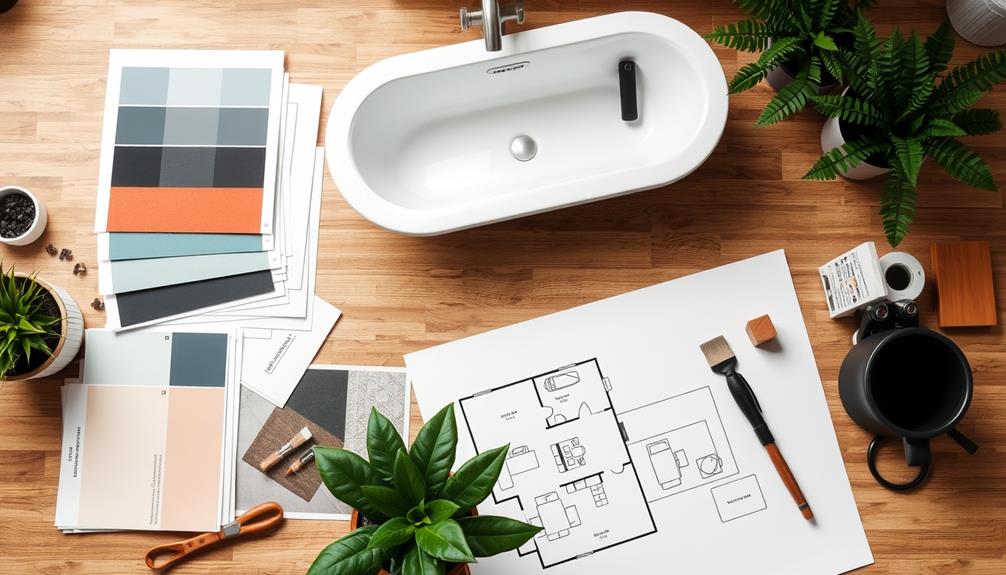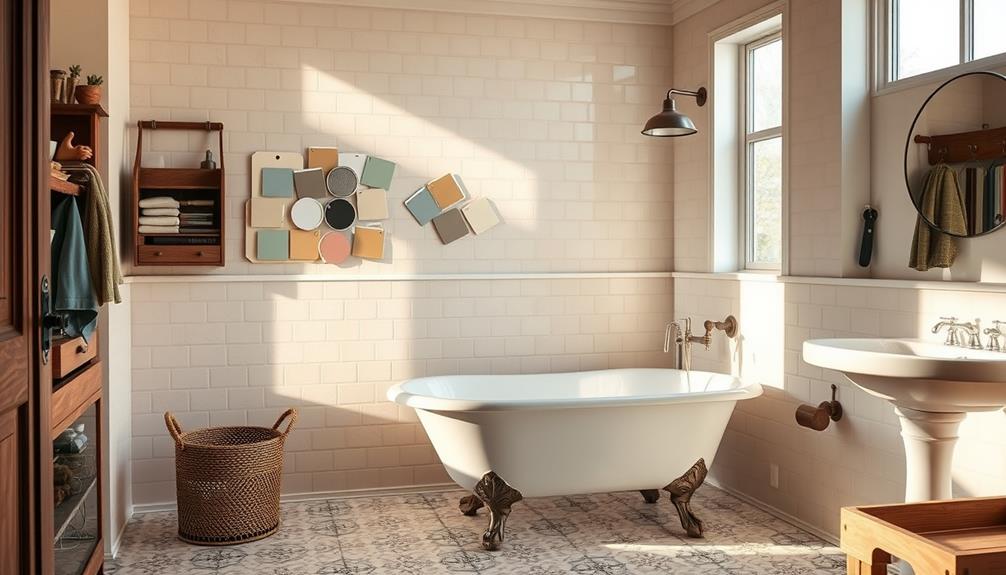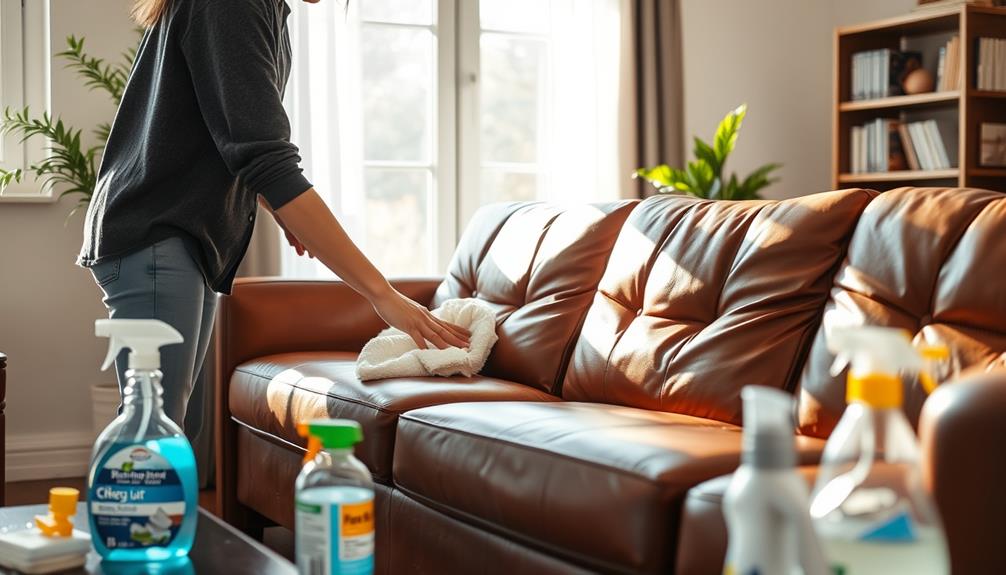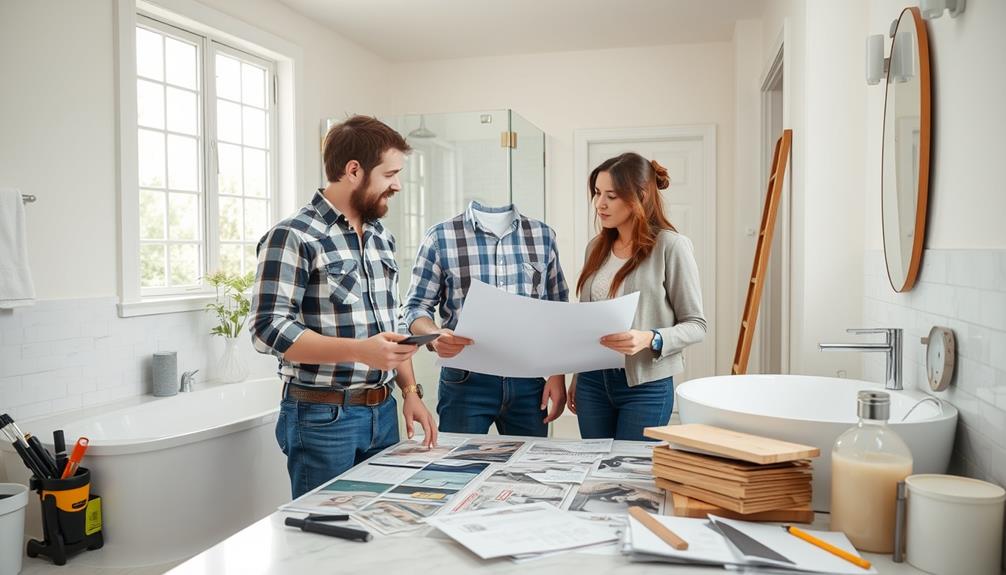When preparing for a bathroom renovation, begin by assessing your current layout and noting any functional issues. Establish your design vision by exploring different styles and creating mood boards. Develop a practical budget that covers all expenses, such as permits and unforeseen costs. Determine if you will handle the project yourself or hire a licensed contractor for more complex tasks. Remember to consider necessary permits and inspections. Prioritize durability and moisture resistance when selecting finishes and fixtures. Lastly, pay attention to the installation process for a beautiful final result. There are many factors to consider when starting this transformation! Obtain quotes from multiple contractors to compare prices and ensure you are getting the best value for your bathroom renovation. It is also important to set aside a contingency fund for unexpected expenses during the renovation. By carefully planning and considering all aspects of the project, you can achieve the bathroom you have always dreamed of while staying within your budget. When estimating bathroom renovation costs, be sure to include all potential expenses to avoid financial surprises along the way.
Key Takeaways
- Assess the current bathroom layout to identify functional pain points and evaluate plumbing and electrical configurations for potential changes.
- Define your design vision by exploring styles, creating mood boards, and balancing aesthetics with functional requirements.
- Set a realistic budget that includes all costs, such as materials, labor, permits, and unexpected repairs to avoid financial strain.
- Decide whether to undertake DIY tasks or hire a licensed contractor, considering skill level, time availability, and complexity of the work.
- Plan for permits and inspections to ensure compliance with local building codes and avoid complications during the remodeling process.
Assess Current Bathroom Layout
When you plunge into planning a bathroom remodel, the first step is to assess your current layout. Start by measuring the existing dimensions and noting the positions of key fixtures like the toilet, sink, and shower. This will help you create an accurate floor plan.
Look for functional pain points in your current layout, such as cramped spaces or inadequate storage, so you can prioritize changes that enhance usability. Additionally, consider your budget and any potential financial implications of your remodel, as creating a personal budget will guarantee you stay on track financially.
Next, consider the flow of the bathroom. Make sure that doors swing open without obstruction and that there's enough space for movement between fixtures. This attention to detail can greatly improve your daily experience.
Don't forget to assess the plumbing and electrical configurations. Understanding these elements helps determine what changes are feasible without extensive renovations, as moving plumbing can considerably increase costs.
Once you've gathered this information, create a sketch of your ideal bathroom design. Incorporate desired features and amenities to visualize your improvements. This sketch will be invaluable when discussing your plans with a contractor, who can provide practical feedback based on your current layout and aspirations.
Define Your Design Vision
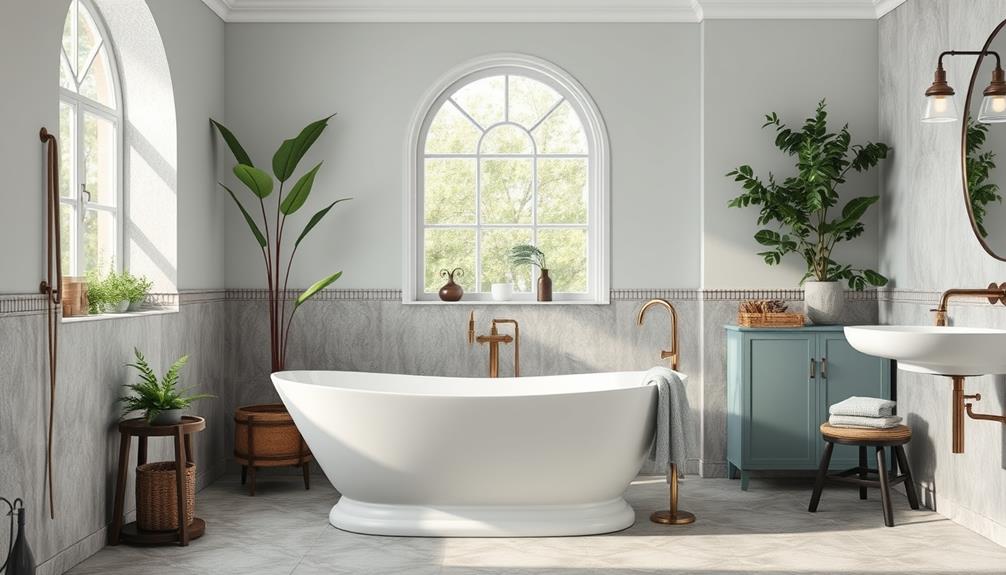
To define your design vision, start by identifying your style preferences—whether it's modern, rustic, or something else entirely.
Reflect on how a remodel can enhance your home's energy efficiency, drawing inspiration from the living aspects of tiny houses that prioritize functionality and minimalism.
Don't forget to take into account your functional requirements, like storage and accessibility, to guarantee your new bathroom works for your lifestyle.
Balancing aesthetics with practicality will help you create a space that's both beautiful and functional.
Identify Style Preferences
Exploring various design styles is vital for defining your bathroom's aesthetic vision. Start by evaluating different styles, like modern, traditional, or rustic, to find what resonates with you and complements your home's overall theme.
Once you have a direction, utilize platforms like Pinterest and Instagram to create mood boards. These boards will help you visualize your desired finishes, colors, and fixtures, ensuring a cohesive design vision. Additionally, keeping a design journal can aid in tracking your evolving preferences and inspirations, which is essential for a successful remodel.
As you research, pay attention to current trends, such as minimalist designs combined with luxury finishes, which often blend beauty with practicality inspired design styles. This approach allows you to incorporate contemporary elements while maintaining a timeless appeal.
Don't forget to contemplate color palettes that harmonize with your chosen style, as they play a vital role in the overall ambiance. Consulting with design experts or visiting showrooms can provide valuable insights into the best materials and fixtures that align with your preferences.
Additionally, think about storage solutions; they should be both functional and visually appealing to enhance your space. By identifying your style preferences early on, you'll set a strong foundation for your bathroom remodel.
Consider Functional Requirements
After pinpointing your style preferences, it's time to contemplate the functional requirements of your bathroom. Start by evaluating your current bathroom layout. Identify any pain points, like inadequate storage or awkward fixture placements. This evaluation will inform your design vision and highlight necessary changes.
Additionally, consider how the role of color accuracy in home cinema projectors can inspire your color choices and overall aesthetic, ensuring a cohesive and appealing look.
Next, define your desired amenities. Whether it's a soaking tub, walk-in shower, or double vanity, knowing what you want will help you prioritize features that enhance both functionality and comfort. Keep in mind that some of these amenities may require plumbing changes or structural considerations, especially for heavier installations like a soaking tub.
To visualize your ideas, create sketches of your ideal bathroom design. This will help you discuss your vision with a contractor, ensuring practicality aligns with your dreams.
Additionally, be aware of potential material shortages that could impact your timeline. Delays in obtaining specific finishes or fixtures might necessitate adjustments in your planning process.
Set a Realistic Budget

Setting a realistic budget is essential for a successful bathroom remodel. Begin by establishing a thorough budget based on typical remodeling costs, which can range from $15,000 to over $30,000, depending on the extent of renovations and materials you choose.
Additionally, consider allocating funds for investments that may offer long-term value, similar to how Gold IRAs for retirement planning function in the domain of financial investments. Identify key areas where you can splurge, such as high-quality plumbing fixtures, while looking for budget-friendly alternatives for non-essential items.
Don't forget to account for additional costs like permits, demolition, labor, and any unexpected repairs that could arise during the process. These expenses can greatly impact your overall budget, so it's wise to have a buffer in place.
As you refine your budget estimates, make certain that all necessary materials and services are included to avoid financial strain later on. Regularly reassess your choices and adjust your budget accordingly to stay on track.
Explore Financing Options
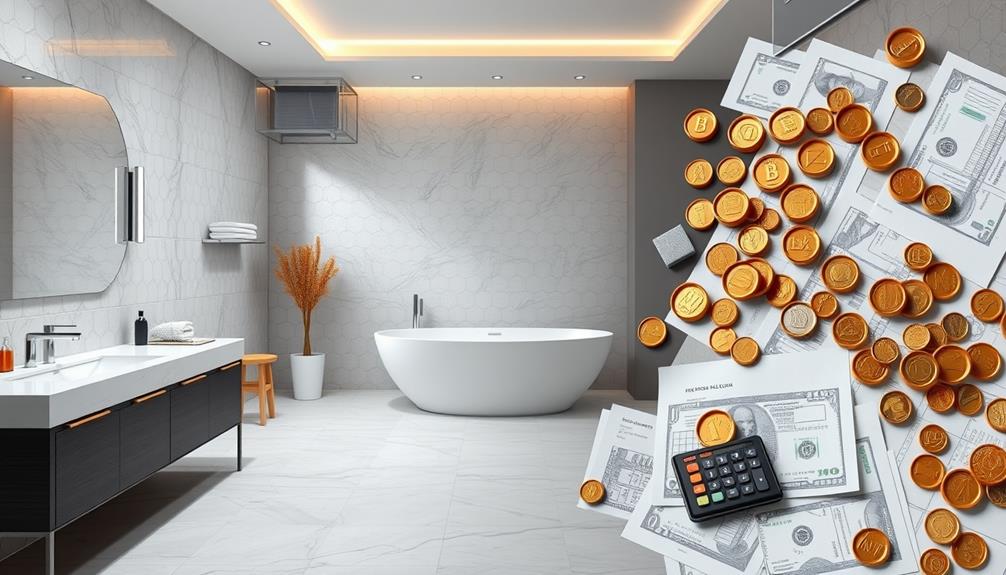
When planning a bathroom remodel, it's important to contemplate your financing options early on. Understanding the various methods available can help you make informed decisions that align with your budget.
| Financing Option | Pros | Cons |
|---|---|---|
| Home Equity Loans | Lower interest rates, large amounts | Risk of losing home if you default |
| Personal Loans | Quick approval, no collateral required | Higher interest rates |
| Credit Cards | Convenient for small expenses | High-interest rates if not paid promptly |
| Government Grants | Potentially free money for eligible projects | Limited availability, specific criteria |
Home equity loans are popular, allowing you to borrow against your property's equity. Alternatively, personal loans can be an appealing choice for quicker access to funds, though they usually come with higher rates. For smaller expenses, credit cards can be useful, but be cautious of accumulating debt. Some contractors offer financing options, making it easier to manage costs over time. Additionally, look into government grants and assistance programs that might be available for energy-efficient upgrades or accessibility improvements. Exploring all these financing options will help you navigate your remodel more effectively.
Decide Between DIY or Contractor
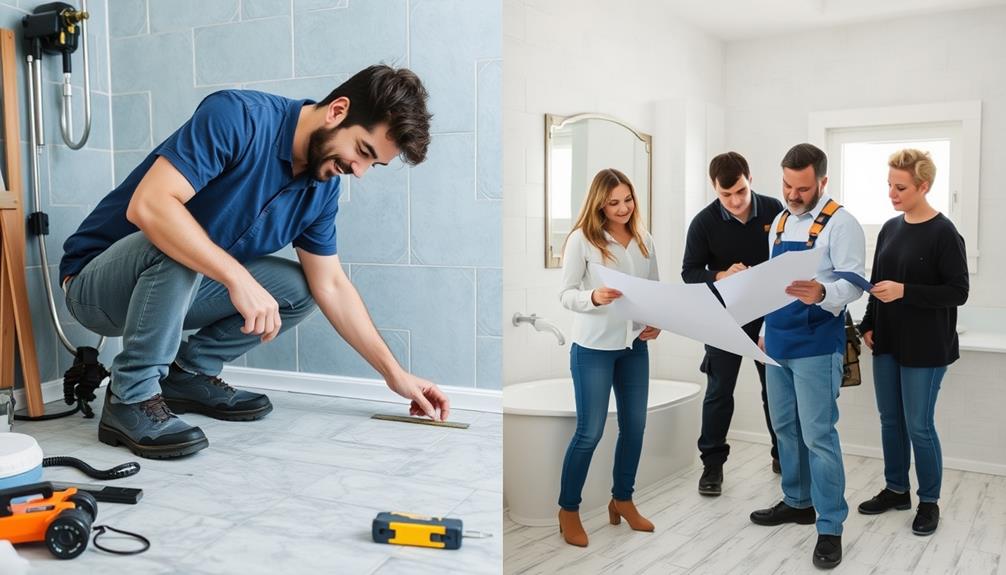
Often, deciding between DIY or hiring a contractor can greatly impact your bathroom remodel's success. Start by evaluating your skill level and experience. If you're comfortable with basic tasks, you might handle surface changes.
However, for complex tasks like plumbing work or electrical installations, hiring a licensed general contractor is usually the way to go. They guarantee compliance with local building codes and can navigate permits efficiently, saving you time and preventing costly mistakes.
Additionally, just as a security system can deter potential issues in your home, a professional can foresee challenges that might arise during the renovation process increased safety and peace of mind.
Consider the scope of your bathroom renovation. If it involves moving fixtures or altering layouts, a contractor can manage these extensive changes more effectively.
They also come prepared for unexpected issues that might arise during renovations, minimizing delays and additional costs.
Plan for Permits and Inspections
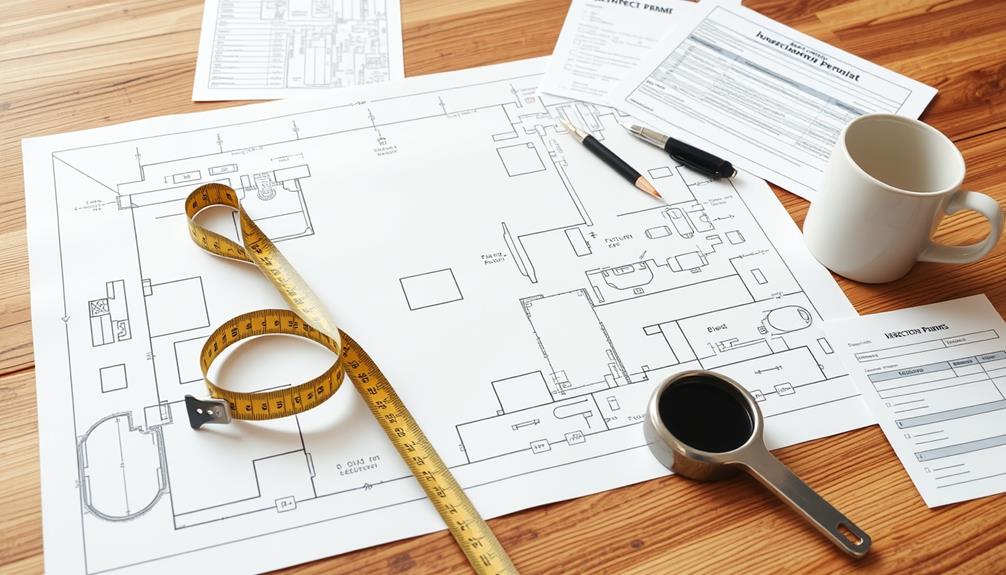
Before diving into your bathroom remodel, you should always check local building codes to find out which permits you'll need. Typically, a building permit is required for any work that involves moving or replacing plumbing fixtures, electrical systems, or structural elements.
Understanding the financial implications of any remodeling work, including potential costs associated with compliance, can also help in your planning. The specific requirements can vary by municipality, so it's crucial to do your homework, especially if you want to avoid complications similar to those faced in financial considerations for elderly care.
Here are some key points to keep in mind:
- Consult a licensed contractor: They can guide you through local regulations and expedite the permitting process.
- Schedule inspections: Arrange for inspections at critical stages, such as after rough plumbing and electrical work, to verify compliance.
- Avoid fines: Failing to obtain the required permits can lead to costly fines or complications when selling your home.
- Stay compliant: Confirming all work is up to code protects you and maintains your home's value.
Manage Demolition and Preparation
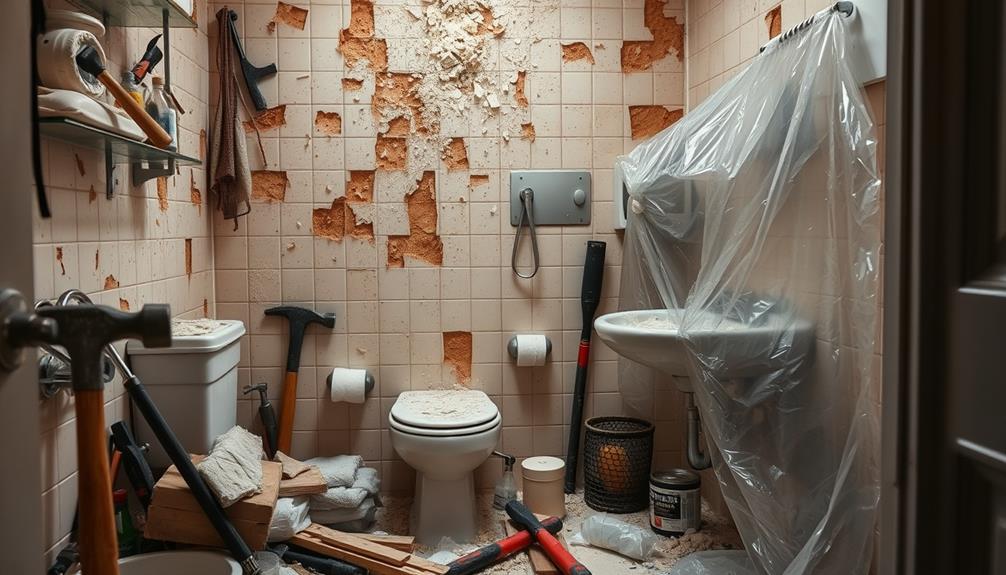
Before you start tearing things down, make sure to plan for temporary facilities, especially if your bathroom will be out of commission for a while.
Consider consulting with professionals regarding best practices for organizing prep tables to avoid unnecessary disruptions.
You'll also need to keep track of inspections and approvals to stay compliant with local codes.
Efficiently coordinating the demolition process will help you shift smoothly into the installation phase.
Temporary Facilities Planning
Planning for temporary bathroom facilities is essential when managing your remodel. Before starting demolition, you need a solid plan to guarantee continued access. Here are some options to take into account:
- Use a guest bathroom if available.
- Rent a portable toilet for convenience.
- Set up an alternative shower solution, like a handheld showerhead in a bathtub.
- Reflect on the importance of unique camping experiences when planning your home improvements.
- Communicate with household members about the timeline and expectations for bathroom availability.
While bathroom remodeling can disrupt daily routines, effective communication minimizes inconvenience. Make sure to keep your lines of communication open with contractors, scheduling demolition and construction work efficiently to reduce the duration of temporary facilities usage.
Also, don't forget about plumbing and electrical inspections—they should be scheduled early to avoid delays. This guarantees your temporary facilities remain functional throughout the remodel.
Inspection and Approval Process
The inspection and approval process is vital for a successful bathroom remodel. Before you start demolition, schedule inspections and obtain necessary approvals from town officials. This guarantees your project complies with local building codes for plumbing and electrical work.
Proper sequencing of work is imperative; coordinate with your contractors to schedule inspections at the right stages of your remodel to avoid delays. Additionally, understanding the legal process of divorce can help you manage any personal changes that may occur during your remodel.
A thorough pre-demolition inspection helps you identify any potential structural issues, such as load-bearing walls or plumbing complications that could impact the renovation.
Don't forget to document all inspections and approvals. Keeping a clear record can be beneficial for future renovations or when selling your property.
Additionally, maintain open communication with your neighbors if shared facilities are affected during the demolition. This fosters cooperation and minimizes disruption.
By prioritizing the inspection and approval process, you'll set a solid foundation for your bathroom remodel, guaranteeing you stay compliant and on track.
Efficient Demolition Coordination
Once inspections and approvals are in place, it's time to focus on efficient demolition coordination. This phase is vital to guarantee your bathroom remodel runs smoothly and safely.
Start by shutting off the water supply and electricity at the main breaker box to avoid leaks and electrical hazards. Then, remove all accessories and non-fixed objects from the bathroom to create a clear working space.
Here's a quick list of things to prepare for demolition:
- Schedule inspections for new plumbing and electrical work.
- Coordinate with contractors for efficient sequencing of demolition tasks.
- Plan for alternative restroom and shower options during the remodel.
- Safely store items being replaced to prevent damage.
Choose Finishes and Fixtures
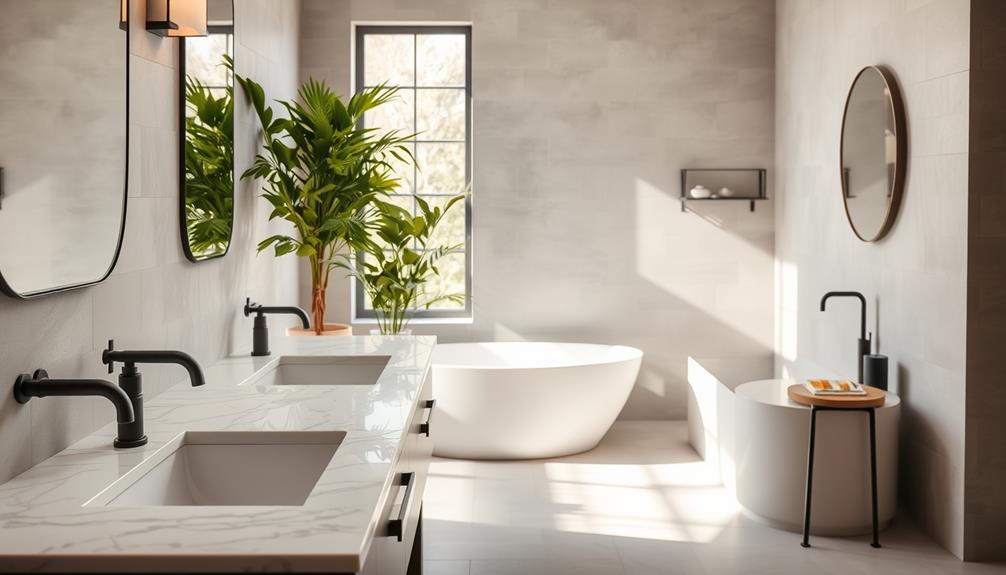
Choosing finishes and fixtures is an essential step in your bathroom remodel, as these elements set the tone for the entire space. Start by selecting moisture-resistant materials like ceramic or porcelain tiles for your tile work. They not only look great but also withstand the humidity found in bathrooms. For added durability in your shower walls, consider using a RedGard waterproofing membrane.
Next, think about the fixtures. Choose ones that align with your design aesthetic—modern faucets in brushed nickel or matte black can elevate a contemporary bathroom. Pay attention to the size and scale of your fixtures; a vessel sink on a floating vanity offers a sleek, modern look, while a pedestal sink saves space and adds a classic touch.
Don't forget about grout colors. Lighter grouts can create a fresh appearance, whereas darker grout can effectively hide stains and imperfections.
Finalize Installation and Decor
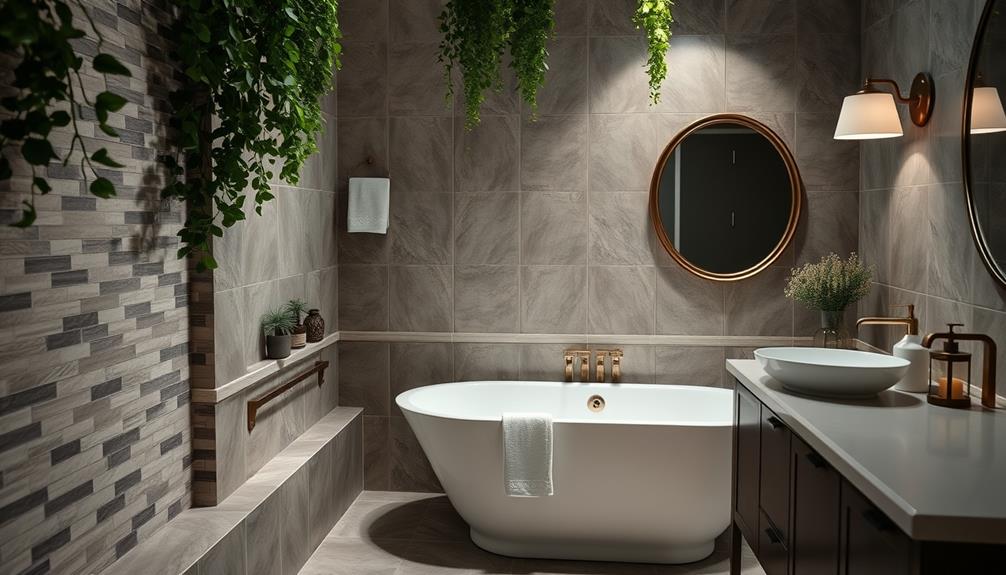
A successful bathroom remodel hinges on the careful installation of fixtures and thoughtful decor choices. Before you proceed with the final decor elements, make certain all fixtures—like the vanity, sink, toilet, and shower—are installed securely and comply with plumbing codes. This lays a solid foundation for the rest of your project.
Next, focus on selecting decor items that enhance your space. Consider the following elements:
- Rugs that match your color scheme
- Mirrors to create an illusion of space
- Lighting fixtures that provide both functionality and style
- Storage solutions, such as shelving and towel bars, that complement your vanity hardware
Once you've settled on decor, finalize your wall treatments. Opt for moisture-resistant paint to guarantee longevity and protection against humidity.
Personal touches, like living plants and unique accessories, can make your bathroom feel inviting and reflect your style.
With careful attention to installation and decor, you'll create a bathroom that's not just functional but also a true reflection of your personality.
Frequently Asked Questions
In What Order Should You Renovate a Bathroom?
To renovate a bathroom, start with demolition, then tackle plumbing and electrical work. Next, install cement board, lay tiles, and finally, add fixtures. Don't forget to complete finishing touches like painting and decor for a polished look.
Where Do I Start When Planning a Bathroom Renovation?
Think of planning a bathroom renovation like crafting a recipe. Start by evaluating your current space and defining your goals. Then, gather inspiration, set a budget, and consult a contractor to guarantee everything flows seamlessly. Next, consider the layout and functionality of your space, and research different master bathroom remodel ideas to see what features and designs appeal to you. Once you have a clear vision for your project, gather materials and fixtures that align with your chosen style and budget, and coordinate with your contractor to bring your dream bathroom to life. With careful planning and attention to detail, your bathroom renovation can become a space that perfectly reflects your personal style and meets all of your needs.
How Much Should You Spend on a Bathroom Remodel?
You should expect to spend anywhere from a few thousand to over $30,000 on a bathroom remodel, depending on the scope and materials. Prioritize your budget and consider quality for long-lasting results.
How to Begin a Bathroom Renovation?
Did you know that nearly 70% of homeowners wish they'd started renovations sooner? To begin your bathroom renovation, assess your space, list desired features, consult professionals, and set a realistic budget to kick off the process.
Conclusion
Planning a bathroom remodel can be a rewarding journey that transforms your space into a sanctuary. Remember, 75% of homeowners report increased satisfaction after a bathroom upgrade, proving it’s worth the effort. By following these steps, you’ll guarantee your project runs smoothly and stays within budget. Whether you choose to DIY or hire a contractor, your dream bathroom is within reach. Now, get ready to enjoy your new oasis! If you’re worried about the bathroom remodel cost in UK, there are plenty of ways to cut down on expenses without sacrificing quality. Consider using reclaimed materials or shopping for fixtures and finishes during sales to save money. With a little research and planning, you can achieve the bathroom of your dreams without breaking the bank. So, don’t let cost hold you back from creating the perfect space for relaxation and rejuvenation.
